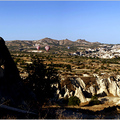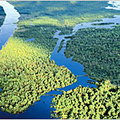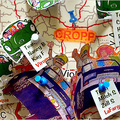MOST visitors to Milan, Italy's center of finance, commerce and design, go looking for gold, literally or figuratively, and so do I. But the gold I search for is culinary. I first realized that is this city's favorite food color some 40 years ago when I found “Vecchia Milano in Cucina,” a small paperback devoted to the lore, history and traditional recipes of Milan and its region, Lombardy. It was printed on chrome-yellow paper to honor sunny local dishes like cornmeal polenta, veal cotoletta Milanese, with its crisp golden breading, and the many dishes sparked with orange squashes and zucchini blossoms. Egg yolks tint the hot consommé zuppa alla pavese as well as the high and airy sweet Christmas bread, panettone.
But of all culinary trademarks, the most elegant is the winey, saffron-gilded risotto Milanese, the short, wide-grained vialone rice from the Po Valley, creamy with butter and marrow then etched with grated Parmesan, whether as a course in itself or as an accompaniment to the spoon-tender braised veal shank, osso buco. For me that heavenly rice dish attains its true apotheosis when it morphs into the wonderous risotto al salto, a thin pancake formed of leftover risotto, fried to parchment crispness on one side then flipped (or jumped — salto) to the second side in a swirl of hot butter, the preferred cooking fat of Lombardy. It is the specialty I search out more than any other because I rarely find it anywhere else, neither in Italy nor the United States.
Not that seeking it out is a chore, for Milan is perhaps Italy's most surprising city, at first glance a drab and hectic center of business that gradually reveals a bounty of enchantments. It mainly attracts serious visitors there to wheel and deal or to see innovative designs in furniture and fashions.
Thousands will gather this month for the Salone Internazionale del Mobile, the vast presentation of new home and office furniture, as well as lighting fixtures, rugs and other decorative accessories in the sprawling New Milan Fairgrounds.
The coolest creations in men's and women's fashions parade down runways several times each year. Between showings, fashionistas catch up in the boutiques along streets bordering Via Monte Napoleone. Music lovers head for La Scala, probably the world's most revered opera house, while art students feast on fabled masterpieces like Leonardo's subtly restored “Cenacolo” (“The Last Supper”) in the refectory of the 15th-century Church of Santa Maria delle Grazie. There are also splendid works in the palatial Pinacoteca di Brera, with its collection of Northern Italian art from the 14th to 18th centuries, and in the Frick-like mansion, Museo Poldi Pezzoli, an engaging setting for works by Botticelli, Bellini and a magnificent diptych by Hans Memling. Nor would any dedicated art lover skip the Pinacoteca Ambrosiana, where Caravaggio's exquisite “Basket With Fruit” hangs among hundreds of icons of European art. All this and the awe-inspiring Duomo, among the largest churches in the world, begun by Duke Gian Galeazzo Visconti in 1386, with some 140 curlicued spires that make it look like a giant sand castle. Among other antique architectural triumphs is the Castello Sforzesco, a fortress built in the second half of the 14th century that was converted to a ducal residence in the mid-15th century. Today, one can view historic ducal rooms there as well as exhibitions of traditional and contemporary art.
In Milan, as elsewhere, to eat traditionally is to sample history. According to Ada Boni, the late doyenne of Italian cooking, the preference for gold-tinted food dates from to the 14th century when dishes for the European elite were trimmed with gold leaf, not for ostentation but because that costly garnish was considered a panacea. Legend has it that an impecunious painter from nearby Brianza brightened his wedding risotto with a harmless pigment. Under Spanish influence, saffron eventually became the coloring of choice, thereby adding an exotic burnish of flavor. Perhaps this taste for all things golden inspired Dolce & Gabbana to name its new restaurant Gold and design the interior entirely in that color. Or perhaps the owners had something else in mind.
There is history, too, in a culinary rivalry between the people of Milan and their Austro-Germanic occupiers, first the Longobards from 569 to 774 who gave the region its name, and during much of the 18th century and into the 19th, the Hapsburgs. The argument runs, “Which came first — the Wiener schnitzel or the cotoletta Milanese?” Despite a few technical differences, Italians base their claim on a document in the Sant'Ambrogio library that describes a banquet in 1134 when a breaded or panéed veal cutlet, lombolos cum panitio, was served.
Milan's cuisine features many other specialties, most of which I sampled en route to the cherished rice pancake. It is easy enough to find them, even in the tourist restaurants that line the aisles of the 19th-century skylighted Galleria Vittorio Emanuele II, a great place to down an espresso and watch the operatic street life. The real challenge, though, is finding those dishes well-prepared, and last fall I got lucky.
Knowledgeable friends first whisked me and my husband, Richard Falcone, to Bebel's Ristorante, a smartly casual and urbane Art Nouveau setting in the Brera-San Marco district. Rarely listed in travel guides and packed with fashionable devotees including Miuccia Prada, it is popular with journalists from the nearby offices of Corriere della Sera, Italy's most prestigious newspaper. With Jean-Paul Belmondo's nickname, Bébel, as an inspiration for his restaurant, Sergio Sorini, a native of Montecatini in Tuscany, features a few pizzas and dishes of all Italy with ample representations of Lombardy.
Entering the large convivial dining room via an aisle lined with market displays of fish and shellfish, fruits and vegetables, cheese and cured meats, I could hardly wait to get my hands on a menu. Then came the embarassment of choice leading to the most rewarding results. Because the earthy ovoli and porcini mushrooms were in season, we sampled those tossed raw in an appetizer salad, plus another of tender artichoke hearts glossed with lemon and olive oil. The risotto Milanese had just the right satiny gilding, but alas, there were no leftovers for al salto that evening. Properly pink at the center, calf's liver in Lombardy is lightly sautéed, piccata style, with a simple flourish of minced parsley and lemon juice, and though the veal for the cotoletta Milanese was pounded a bit too thin for my taste, it had just the right crunch and toasty veneer of breading. Grilling is a specialty at Bebel's and rendered very fresh fish, orata and branzino, to moist, pearly perfection.
More concentrated Milanese menus are featured at two restaurants, very different in tone and style, but each worth a visit. The less expensive and more relaxed is the funky 74-year-old Trattoria Milanese, set midst winding narrow streets lined with shops that sell antiques, books and crafts in one of Milan's oldest sections. The communal tables in several large rooms fill up rapidly at lunch with a mix of suits from the nearby stock exchange, neighborhood ladies who lunch and tourists from Italy and abroad. Handsome brick arches, romantically amateurish water colors, copper pots, faded posters and photos almost distract one from walls that, here and there, could use paint and plaster.
More reassuring is the menu that reads like an index for a Milanese cookbook. The cool salad of cartilaginous pork and veal tendons, nervetti, comes as an appetizer along with carpione, tiny onion and vinegar dressed cold veal cutlets. Minestrone can be had with pasta or the more traditional rice, and in summer is served slightly chilled. Like other dishes presented in the straightforward casalinga (or “housewife”) style, both the risotto Milanese and the al salto are convincing and heartily portioned. Soft mounds of polenta may be enhanced with the braised beef stew, brasato, or a cozily overcooked osso buco, or, big light meatballs in a tomato ragù. Other classics include zampone with lentils, fried eggs and Gorgonzola atop polenta, and mondeghîli, a sort of fried hash cake of chopped beef, meaty Milan sausage, liverwurst, parsley, breadcrumbs and grated Parmesan. The tripe soup-stew busecca, billed here as foiolo (foijoeru in local dialect) is offered with the other fried or stewed innards dear to Milanese palates. Zabaglione (zabajon on this menu) is more Piemontese than Lombard, but why quibble about a dessert this soothingly warm and thick and gently perfumed with Marsala?
By all odds, the most precise, perfect renderings of the Lombard kitchen are at Antica Trattoria della Pesa, a suavely professional place with dark wood paneling and belle époque furnishings in several smart rooms that are usually filled with savvy locals. Close to the awesome Cimitero Monumentale, the sculpture-filled cemetery that is the resting place of many financial, political and artistic notables, Pesa has been here since 1882 at was once a weigh station with an old scale outside to prove it.
Here the risotto al salto was just thick enough to have a creamy center still redolent of saffron while the outside was parchment crisp and buttery, and the basic risotto had an aromatic blend of that spice plus rich overtones of butter, cheese and dry white wine. Polenta with brasato and supple osso buco with the proper gremolada topping of lemon rind, parsley, garlic, and mashed anchovies could not be better. Pesa's rendition of the city's famed cotoletta reminded me why I so much favor that breaded veal cutlet, even as Wiener schnitzel — something about just the right thick-thin juiciness of meat, the subtle blend of salt and peppered crumbs and the dash of lemon on top that is soothing simplicity at its best. If on my visit Pesa did not have the mixed boil of meats that is bollito misto, it did successfully serve a wonderfully lusty cassoeula, a casserole of various cuts of fresh and cured pork and sausages with Savoy cabbage, carrots, celery and onions and thick, meaty cotechino sausage nested on whipped potatoes.
I had my eye on dessert upon entering and wisely did not stray from my choice of tiny pears baked in spice-scented red wine to achieve a rich mahogany patina. Even so, I appreciated generous friends who let me sample the airy vanilla soufflé and the satiny zabaglione.
Not all products of Milan and Lombardy can be found in restaurants, so to fill in I went, as usual, to Peck, a jewel of a fancy grocery store laid out on four elegant floors with a stunning wine cellar featuring the world's best vintages along with a few modest Lombard reds like the robust, rose-gold Sassella, the somewhat milder Grumello and the light, nut-flavored Inferno. Of the extraordinary cheeses of this dairyland province, the noblest is the tangy, complex Gorgonzola. Milder but seductive examples are taleggio and stracchino and the frothy, freshly piquant mascarpone. In late fall and winter, Peck sometimes offers a terrine layered with those four cheeses and slivers of aromatic white truffles.
Among the preserved meats of the region, Peck displays at least 25 local variations on salami alongside mortadella di fegato, the thin, dry luganega and zampone (a pig's foot stuffed with peppery, coarsely ground pork mixture much like cotechino). These as well as a dozen types of cured ham and beef are on view with the region's breads, candies, cakes and more. I always buy samplings to nibble at leisure in my hotel room, though many are served at the several cafes within the shop. Alas, there is no longer the Peck rosticceria where I used to gorge on sandwiches of hot, garlicky cotechino with sauerkraut, further evidence of Milan's relationship with Germans and Austrians. Many of the same posh local specialties, albeit in a much smaller array, are at Il Salumaio di Montenapoleone, both in the neatly laid out shop and in the charming courtyard cafe.
For a sweet finish, and at the advice of a longtime family friend, Silvia Latis, the director of the design magazine, Abitare, I worked my way to Pasticceria Bastianello close to the Piazza San Babila and its restored 11th-century church. From the flaky hot canapés served in the evening with aperitivos at the bar to the velvety sweet marrons glacé, the bittersweet chocolate-covered kikingi (little tart orange Cape gooseberries) and dessert pastries, this gracious setting provided a felicitous ending for my own last supper in Milan.
VISITOR INFORMATION
WHERE TO EAT
Restaurant prices are for a three-course meal for two before wine but with tax and tip.
Antica Trattoria Della Pesa, Viale Pasubio, 10; (39-02) 655-5741. About 110 euros, or about $150 at $1.36 to the euro. Closed Sundays.
Bebel's Ristorante, Via San Marco, 38; (39-02) 657-1658; bebels2@libero.it. Closed Wednesdays and lunchtime on Saturdays. About 100 euros.
Trattoria Milanese, Via Santa Marta, 11; (39-02) 8645-1991. About 80 euros.
Peck, Via Spadari, 9; (39-02) 802-3161; www.peck.it. Closed Sundays and Monday mornings.
Pasticceria Bastianello, Via Borgogna, 5; (39-02) 7631-7065.
Il Salumaio di Montenapoleone, Via Monte Napoleone, 12; shop (39-02) 7600-1123; restaurant (39-02) 784-650. Closed Sundays.
WHAT TO SEE
La Scala, Piazza della Scala; (39-02) 7200-3744; www.teatroallascala.org.
Santa Maria delle Grazie, Piazza Santa Maria delle Grazie, 2; (39-02) 8942-1146. Tuesdays to Sundays 8 a.m. to 7:30 p.m. Reservations are required for visits at 1.50 euros a person.
Pinacoteca di Brera, Via Brera, 28; (39-02) 722-631; wwwbrera.beniculturali.it. Tuesdays through Sundays 8:30 a.m. to 7:30 p.m. Admission 5 euros.
Pinacoteca Ambrosiana, Piazza Pio XI, 2; (39-02) 806-921; www.ambrosiana.it. Tuesday to Sunday, 10 a.m. to 5:30 p.m. Admission 7.50 euros.
Duomo, Piazza del Duomo; (39-02) 7202-2656; www.duomomilano.it.
Museo Poldi Pezzoli, Via Manzoni, 12; (39-02) 794-889; www.museopoldipezzoli.it. Tuesday to Sunday 10 a.m. to 6 p.m. Admission 8 euros.
Castello Sforzesco, Piazza Castello; (39-02) 8846-3700; www.milanocastello.it. Open Tuesday through Sunday 9 a.m. to 5:30 p.m. Admission to the castle is free; 3 euros for the museums.
WHERE TO STAY
Town House 31, Via Goldoni, 31; (39-02) 70-156; www.townhouse.it/th31/. This low-key converted town house in a residential neighborhood has 19 rooms designed by an editor from Architectural Digest. Rooms start at about 230 euros.
Bulgari Hotel, Via Privata Fratelli Gabba, 7B; (39-02) 805-8051; www.bulgarihotel.com. Over-the-top Italian luxury: Frete sheets, black granite soaking tubs and a sprawling private garden. Starting at 520 euros.
Straf Hotel, Via San Raffaele, 3; (39-02) 805-081; www.straf .it. This sleek boutique hotel has small but cozy rooms in a 19th-century building just around the corner from Prada and Missoni. Rooms start at 270 euros.





